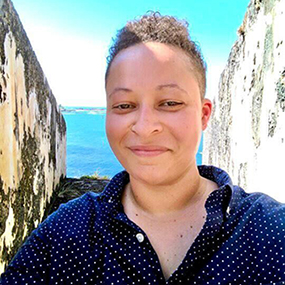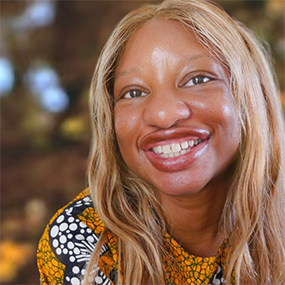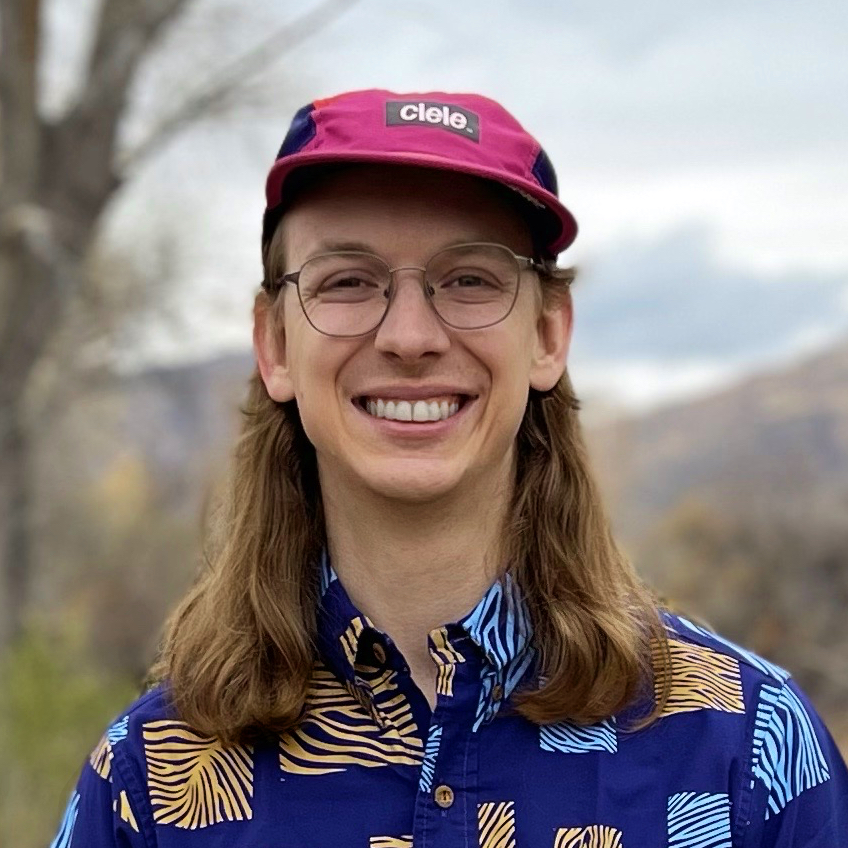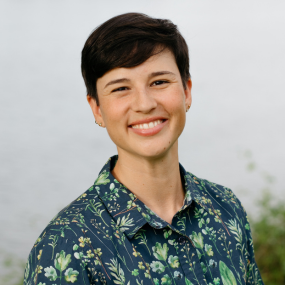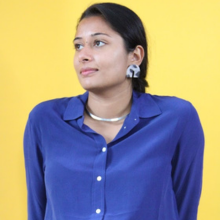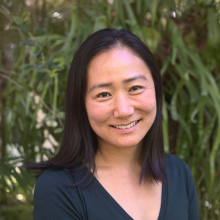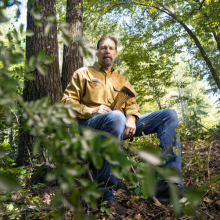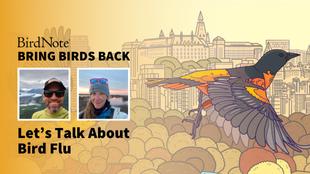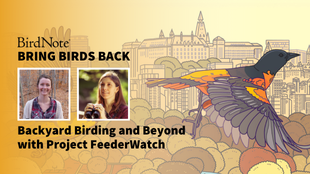

Join BirdNote tomorrow, November 30th!
Illustrator David Sibley and actor H. Jon Benjamin will face off in the bird illustration battle of the century during BirdNote's Year-end Celebration and Auction!
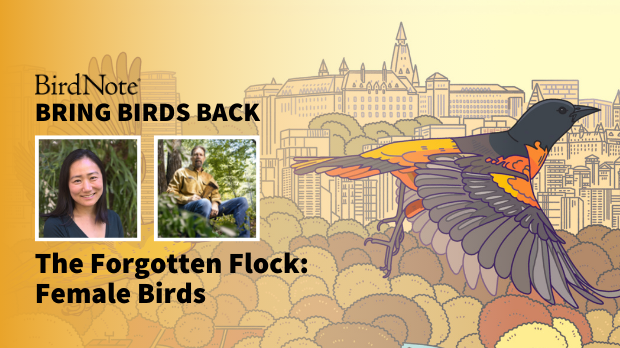
How much do you know about the lives of female birds? And could you identify, say, a male Scarlet Tanager from a female?
This episode’s host (and co-founder of the Galbatross Project), Purbita Saha, is here to explain why studying female birds is important. Joining her, ornithologist Joanna Wu details how the often overlooked and understudied female birds are crucial to bird conservation efforts. And wildlife ecologist, Michael Chamberlain, shares his vast knowledge about turkeys – a species whose survival was greatly impacted by a significant increase in research about turkey hens.
For more information about the From Love to Action campaign, visit this page.
Want more Bring Birds Back? Subscribe to our show and follow us on Instagram! For more about BirdNote, sign up for our weekly newsletter. And for ad-free listening and other perks, sign up for BirdNote+ here.
BirdNote is a nonprofit. Your tax-deductible gift makes these shows possible.
Bring Birds Back Special Season 6 is sponsored by the Cornell Lab of Ornithology and the American Bird Conservancy.
Purbita Saha: BirdNote Presents.
[Bring Birds Back Stinger]
Purbita Saha: From BirdNote, this is Bring Birds Back. I’m Purbita Saha and I’ll be your co-host this season. For those of you who don’t know me yet, I’m a science journalist from New Jersey — and a major bird nerd.
[Music starts]
A few years ago when I was still a fledgling birder, I had a thought: Why did I care so much about identifying male birds but not female birds? Sure, it’s easier to ID male birds for most species, but where’s the fun and fairness in that? I got even more fired up in 2018 after reading an essay in Audubon magazine by naturalist Kenn Kaufman where he argues, “an unconscious bias against female birds is widespread in birding.”
You don’t have to look far for examples. I mean, take a peek at any bird trinkets around your house. I'd be willing to bet that they mostly depict male birds. Google a species name or look in any birding app — many of the leading photos and descriptions feature the male counterparts. Even descriptive common bird names in English are overwhelmingly based on traits that only the males have: Red-winged Blackbirds, Black-chinned Hummingbirds, Long-tailed Ducks, Scarlet Tanagers — I can go on and on.
[Music fades]
So yeah, birding has a problem. And Kenn and I aren’t the only ones to recognize it. In 2019, a few of my National Audubon Society colleagues and I competed in the World Series of Birding. This event sees birders from around the world travel to Cape May, New Jersey, to find as many species as possible in 24 hours– it can get pretty wild. Some of them scout and train for weeks for a chance at gold. But my teammates and I took a different approach:
[Music change]
We only counted birds that we could identify as female. We didn’t come close to winning, but we learned a lot from being in the field.
From there, we decided to collect knowledge on female birds every time we went birding—and share it with anyone who would listen. And so the Galbatross Project was launched, aiming to get birders, photographers, ornithologists, and conservationists to notice and appreciate female birds more. And it’s working.
Today, we’ll talk about why we need more female-bird love with two wise and witty guests. Michael Chamberlain, a wildlife ecologist at the University of Georgia, will give us a look into the complex lives of female wild turkeys. But before we talk turkey, I’m jazzed to introduce you to ornithologist and ecologist, Joanna Wu, a co-founder of the Galbatross Project with me, Brooke Bateman, Martha Harbison, and Stephanie Beilke.
Joanna is publishing studies and leading a symposium on the same topic at the American Ornithological Society conference in October. And best of all, she’s taught me and many others about the wonders of female bushtits, lady hummingbirds, and more.
[Music fade-out]
Purbita Saha: So we have known each other for a few years now. We used to work at the National Audubon Society together. We've gone birding together a little bit. She brings her Western bird expertise into my world, which is greatly needed. And now we work together again, as co-founders of the Galbatross Project.
So good to see you. To start, would you just give us a little background on who you are, what you work on?
Joanna Wu: Yeah, good to see you, Purbita, and thanks for having me on the show. My name is Joanna Wu and I am currently a PhD student at UCLA. I'm studying female birds and I'm really excited to be doing this work officially as part of my PhD. Honestly, I'm just inspired by the Galbatross project itself to do my PhD on this important and understudied topic.
Purbita Saha: So, why is the Galbatross Project so important to you?
Joanna Wu: Well, I just can't think of a better cause to devote my time to, honestly. The Galbatross Project and female birds is more than just my work, it's my passion. The issues about gender bias in our society and how women advance less quickly to managerial positions, for example, and how women are disproportionately burdened with things like child care duties, those facts have always bothered me. So when there was a team effort that came up with this great idea to promote and spread the word about female birds, it just felt natural to join forces. And I'm so glad I did.
Purbita Saha: So for those four years, you've been studying how the lack of attention on female birds can be harmful, just to our understanding of the bird world, but also in the conservation of birds. What’s the connection?
Joanna Wu: Right.
So, the way that female birds interface with conservation is that in North America, they tend to be duller and they tend to be understudied because the current methods we have for detecting females are not as robust as for detecting males. that can lead to important gaps in scientific knowledge.
If we don't know as much about a subgroup of of birds we might not be familiar with the places that it needs and the habitats that we need to conserve in order to protect them properly.
Purbita Saha: Does climate change add urgency to the drive to learn more about female birds?
Joanna Wu: Yeah, climate change is one of our biggest threats the natural world is facing right now there's so much room to figure out how climate change is impacting birds and impacting females differently from males. There's almost nothing studied about it. So if we think about fields like, migration.
Typically males arrive when they migrate from the tropics. Males tend to arrive earlier than females and then females come after males have established territories. And the timing of when they arrive has been shown to be changing at different speeds. So males are arriving earlier in the spring but females are arriving at the same time.
So this has led scientists to question what mechanisms drive these differences and what does it mean if females and males aren't arriving at the same time? How does that interface with peak food abundance and insect emergence and all of those things that go into a successful breeding season?
It also impacts nest availability. New species might come into interaction that weren't previously in the same range. And we know that nest sites are already sparse so does that mean there's more potential for competition, especially with birds where females do most of the nesting?
How does that impact females differently? Could they incur more costs through the breeding season? There's just so many questions to be asked.
Purbita Saha: So what are some things you've learned about female birds since you started your PhD?
Joanna Wu: Oh my gosh, I've learned so much and still, I feel like I want to read more and more. But maybe the most surprising thing to me is that annual survival is lower for female birds than male birds.
If we take the example of mammals, women have longer longevity than men do in humans, but that pattern is flipped in birds, such that male birds, on average, have a higher rate of survival each year than female birds do. There are a lot of theories as to why, but I'm also curious uh, are there pressures that are disproportionately harming female birds and is there something we can do to fix it?
Purbita Saha: Can you give us an example of a species where we could understand the survival of the female bird a whole lot better?
Joanna Wu: Yeah, absolutely. The one that comes to mind right away is the Golden-winged Warbler. It's the only species of bird that I know of where they've studied the non-breeding habitats use of males and females separately. And they've actually found that females spend the non-breeding season at lower elevation habitats in Central America.
And these lower elevation habitats are closer to human inhabitation. As a result, female Golden-winged Warblers have lost more of their habitat than males just because of their spatial segregation. But I'm super curious to know if there's any survival differences between the sexes in that species, in particular.
Purbita Saha: Yes, I would love more Golden-winged Warblers to survive. There's a really famous breeding spot near where I live along a power line right of way, so very weird habitat but they do really well there. Good point that we don't know what's happening in these two different worlds on opposite ends of the year, especially among female birds.
Joanna Wu: Yeah, and It's already really informative to figure out where they spent the non-breeding season as a species just because we know so little about the tropical habitats that these migrating birds use.
But to be able to do it on a sex specific level just takes it to a whole new level. And I really think that sort of information could tell us so much in the future.
[Music starts]
Purbita Saha: So what I find exciting about your research is there's so many cross sections of study when we look at female birds as a subset of ecology and wildlife. Can you share a few studies or findings that personally interest you?
Joanna Wu: Well, Purbita, you know how much I love the bushtit.
Purbita Saha: Yes, your California specialty.
Joanna Wu: Yes, yes, if any listener hasn't seen it, when you come to the west coast, you'll see your first bushtit and then you'll see your first 15, ‘cause they're always hanging around in groups. But they're, like, a little bit bigger than an Anna's Hummingbird, so they're really small.
And what's crazy is that the female has yellow eyes and the male has gray eyes. But other than that, the sexes look identical. They're just your typical drab gray brown birds. But, I don't know evolutionarily why this happened, but it's so cool. It's almost like there's a trait just to help us separate out the male and the female in terms of identification.
Another fact that I love is that the Belted Kingfisher is a rare species where the common name better describes the trait of the female. The Belted Kingfisher is named for the rust-colored belt that goes across the chest of the female but the male doesn't have that. He's just blue and white only. You know, that's in contrast to birds like the Blue Grosbeak, where males are blue, but the female is completely brown. So, why would she be called ‘Blue Grosbeak’ and have, like, essentially not a hint of blue on her, you know? The name only describes half the species, really.
Purbita Saha: Yeah, I'm glad you brought up the belted kingfisher. I feel like that's a good female spark bird for people because the difference is so pronounced and easy to spot once you know about it. Although now in my experience, whenever I see a kingfisher, it's always perched with its back toward me. And I'm just like, why?
Joanna Wu: Why are you hiding?
Purbita Saha: Yeah, that's a– that's a great one for folks to look out for.
Joanna Wu: Do you have favorites? Sex specific traits?
Purbita Saha: The female Red-winged Blackbirds have been catching my eye a lot more lately. Although, I would say I'm not as familiar with their vocalizations because they're usually lower in the cattails or the grasslands where they nest.
And if you have a pond that's like covered in lily pads, sometimes the females will be like foraging on the lily pads, so they'll kind of step across them as you would see a gallinule or something.
Joanna Wu: No way.
Beyond the birds where you can visibly tell the difference. With the Galbatross project, we've been looking at ways to sex birds beyond visual clues. That means looking at behavior. And a lot of that behavior happens during breeding season. Like I remember realizing that I saw a female Eastern Kingbird only because this bird that I saw was collecting nest fibers and plant material.
And, um, after looking that up, on Cornell's World of Birds, it was clear, like, ‘Oh, only the females do that. So, I know that I saw a female.’
Joanna Wu: And especially during the fall, for example, a House Finch, right? The male is so bright red, but a juvenile male looks just like a female and that's really, when a lot of these young have fledged, and they're spending their first fall out of the nest and it can be cryptic or tricky to tell the sexes apart.
[Music ends]
Purbita Saha: How do you feel about the level of awareness around female birds right now? Do you think the tides are changing in any way?
Joanna Wu: Yeah, that's a great question. I feel like the reaction that, you know, you or I get when we talk to people about female birds as part of the Galbatross Project is like, ‘Oh, I've never thought about it that way. I– I didn't know that females were different or that I might be accidentally overlooking them.
And I think that's certainly true in bird watching, but that bias also carries over to science, unfortunately. And it's unintentional, um, females are harder to detect in a lot of ways.
When we do go out and look for birds in the breeding season here in North America, we see the males more and therefore we collect more data on them. And that's not, like, malicious or intentional, but it does result in the science world having on average a little less data on females. One research area where we know much more about females than males is in reproductive biology.
It comes from this Darwinian idea that males need to compete with each other to acquire mates and mating opportunities. And females do all the chick rearing. I don't really like to use the word sex roles, it's a little bit limiting, but those traditional sex roles have had a big influence on how scientists collect data and what sorts of data they're looking for.
But I'm hoping that's going to change little by little, you know, with things like Cornell's Birds of North America. Their guide, they sometimes show the female song, in addition to just song and calls because sometimes male and female songs differ. So yeah, the scientists who worked on Female Bird Song Project advocated to make that happen and I'm hoping that we Galbatrosses can help make some scientific changes, perhaps starting with how eBird collects sex data.
On the mobile app, you currently can't designate whether you're reporting a male or female bird. You can do that on the web interface, but a lot of people are just doing it through their phones and submitting checklists that way. But, it's gonna take collecting banding data not only in the breeding season when females may be less active, but also during the fall and migration seasons. We're gonna have to do our audio surveys a little differently to become better at picking up calls and not just training observers on songs. These are all methods that can improve the detection of females, which is step one to understanding them.
[Music]
Purbita Saha: Next up: we get more specific. We’ll be talking all about female wild turkeys, what we’ve come to know about them, and how that’s been impactful to turkey conservation efforts. Right after these messages:
[MIDROLL]
Purbita Saha: Welcome back!
[Music starts]
We’ve been looking at the importance of intentionally focusing on female birds in scientific research and everyday birding– but now, let’s get specific.
[Wild Turkey hens calling]
One species that has benefited from closer study of the females is the wild turkey. Wild turkeys have been part of the North American landscape for millennia. After living alongside Indigenous peoples and being domesticated by them, they were hunted to near-extinction by European settlers and colonists. By the mid-1900s, they had disappeared from most US states.
To keep these gobblers gobbling, local conservation agencies stepped in to restore mixed forests and waterways and relocate wild turkeys from patchwork populations.
Their comeback can be credited to smart conservation practices by wildlife groups and hunters. And, in particular, an uptick in interest in female turkeys. Studies that shed light on their survival rates, social roles, and habitat needs greatly impacted the positive outcome of conservation efforts.
With time, the species’ numbers climbed upward: Now, flocks of wild turkeys roam every US state except Alaska.
Michael Chamberlain: That really is considered one of the greatest conservation success stories in North America.
Purbita Saha: That's wildlife ecologist, Mike Chamberlain. He says when he began his career in the ‘90s, people had assumed the fight for wild turkey conservation was over. As a result, many places are seeing numbers flatline and even decline today.
Michael Chamberlain: Around the late 1990s and early 2000s, we took the foot off the gas, if you will. I think a lot of people stopped paying attention to turkeys because we did think that restoration was complete, and at that time, we had turkeys clearly abundant all over North America.
And then suddenly we started seeing these declines.
Purbita Saha: Mike and his colleagues noted this slow but steady decline over a 20-year-span in a 2015 paper, which resulted in a firestorm of findings that set off alarms nationwide.
Michael Chamberlain: There's no question that populations have declined in many areas. And, not only there aren't as many birds out there as there were but hunters are not harvesting as many birds either.
Indicative that both our female segment of the population and our male segments are declining.
Purbita Saha: It's also fair to say that the conservation effort had a huge impact on Mike. For the past 30 years, he’s spearheaded research on wild turkeys in the Southeast and other regions. In 2023, he founded the Wild Turkey Lab, which he refers to as an archive of information for turkey science.
So, what comes next? How do we replicate the same successes from the past 100 years that helped wild turkeys flourish again?
Michael Chamberlain: Well, I think in some ways that the success that we saw during the restoration phase just speaks to how cooperation and common vision turkey enthusiasts, hunters, agencies, nonprofits, private landowners, public landowners, all putting resources towards a common goal. And so I think the whole restoration program just speaks to how the conservation community can accomplish such lofty goals when everyone works together. And I think that's where I see people coalescing again.
I see the same conversations happening, albeit framed around different issues that I saw 30 years ago.
Purbita Saha: Uh, well, we do want to tap your wisdom about female turkeys.
Female turkeys, for the listeners at home, are called hens, and the male turkeys are called toms. What are some ways to tell hens apart from toms in the field?
Michael Chamberlain: Toms are much larger, twice the size, actually, of the hens. Toms have iridescent black tipped feathers and it causes them to shine.
They have very pronounced parts of their head, such as their skull caps, so the top of their head is a white color. They have reds and blues on the sides of their face and their head and their neck. They're very gaudy-looking, and that's obviously to attract attention from hens. The hens, on the other hand, are much smaller. The tips of all of their feathers are in brown, so when they're sitting on a nest incubating eggs, they want to try to hide. So, they're much more muted in color.
They have feathering that extends all the way up to the top of their head, which makes their heads look much less noticeable versus say the toms that have no feathering on the top of their head. So, when you kind of factor all of that in together, that should help you identify what sex you're looking at.
Purbita Saha: I've also heard that female turkeys have different shaped poop from the males. Is that true and reliable?
Michael Chamberlain: They do. Yes. Yes. The males have, like, a J-shaped dropping and the females have more of just a globular-type dropping. And the other thing, if you're just looking at sign, like droppings, is tracks. You know, the females, their toes are much smaller than the toms. So, if you're, if you're looking at toes that are five or six inches long - even four - you're looking at male tracks versus females that may only have, you know, three inch toes that they're walking around on.
Purbita Saha: Okay. [The] track one is new to me. It's a good one to look out for in fresh snow or such. And in terms of vocalizations, you know, everyone thinks of the classic turkey gobble, which is more specific to the tom. But, the hens have a big range of vocalizations as well, right?
Michael Chamberlain: They do. There was research done many, many years ago by a famous researcher named Lovett Williams. He documented up to 28 different vocalizations that turkeys have. We think about toms as being the ones that gobble, but hens are actually capable of gobbling themselves, although they rarely do it. But yes, there's a tremendous number of vocalizations that start from the time when they're still in the egg. And she does that to imprint those young birds to her so that when they hatch, they will follow her. And so turkeys are very vocal. We believe firmly that they can identify one another based on their voice. And so they talk a lot. When they're in groups, they're constantly making noise.
Very subtle, uh, very soft, little whines and clucks and purrs that help them speak to each other, if you will. And then of course there are more obnoxious calls like gobbles that are designed to draw attention and is what we think about when we think about turkeys calling.
Purbita Saha: And we know that male turkeys have a social hierarchy, especially when they're lucking during the courtship season. But we've also recently learned that females have a pretty complex social hierarchy. Can you explain that and what we know about it so far?
Michael Chamberlain: Sure. So both sexes have these social hierarchies that actually are in place from the time they're very young.
Very pronounced, almost akin to a ladder, where you have a dominant tom, a number two tom, a number three tom, a number four tom, and these hierarchies are very rigid. And they typically don't change unless a bird dies. And so you see the same type of hierarchies with hens, where you have a dominant hen and then let's say you have a number two hen, and she's subordinate to number one, but three through ten are subordinate to her.
And so, these hierarchies influence a lot of how turkeys behave.
For hens, we've determined that the hierarchy dictates who breeds and who breeds when. So the dominant hen, she copulates with the dominant tom in her area and she goes to nest first. And then there's this orderly sequence of events after that where hen number two goes to nest, hen number three goes to nest, number four, and so on and so on.
So that just speaks to how the dominance hierarchy dictates so much of their lives.
Purbita Saha: Can you share one or two facts that have kind of blown your mind when it comes to turkeys?
Michael Chamberlain: Yeah, I think one that sticks out every time I'm asked is, you know, turkeys nest on the ground. So, they sleep in trees at night to avoid predators. But when they decide to lay eggs and incubate a nest, they do that on the ground. We thought for decades that they spent time before they laid that first egg, quote-unquote, “picking the best spot.” And what we've learned as technology has advanced is that they don't do any of that. They literally fly down the morning of laying that first egg, go about their day, and it appears that their body says, ‘Hey, it's time to go ahead and lay some eggs. Go pick a spot.’ And they go do that.
And we think that's probably why no two nest sites look alike. They're all different; there really aren't any patterns except that she can hide there. So that's been one that has kind of created quite a bit of conversation.
Purbita Saha: Do the male turkeys split up the parenting duties with the females, at all?
Michael Chamberlain: They're uni parental. Mom does everything and dad does nothing. So, once breeding is complete, the males go off on their own and the females handle all of the incubation duties.
They're precocial young, so within about 12 hours, they are up and moving away from the nest, and mom simply leads the brood around. And they're capable of feeding themselves immediately.
Mom is responsible until they're old enough to not be such idiots, is kind of the way I think about it, because young turkeys don't have predator avoidance strategies. They're relying on mom to tell them when trouble's nearby. So yeah, being a turkey hen, particularly one that raises poults, is a daunting task.
Purbita Saha: Mm hmm. How do the hens fare with this long list of predators?
Michael Chamberlain: We see annually about 70 percent of hens survive, so we lose about 30 percent each year.
They have a long incubation. You have a bird that spends all year sleeping at night in a tree. And then suddenly for 28 days, they're sleeping on the ground on a nest– it shouldn't be surprising that that's typically when they're, when they're killed.
Purbita Saha: Mmhmm. So Mike, you were talking about some of your interesting findings. Your lab has done multiple studies on how female turkeys choose different habitats. Turkeys are known to be a generalist species, so they can succeed in many different kinds of habitats.
Can you share some of the biggest takeaways and surprises from that kind of nesting-specific research?
Michael Chamberlain: I think probably the one big take home that we found from a nesting perspective is that nesting habitat is rarely limited. Turkeys will nest in a tremendous diversity of locations and vegetative types and we don't see a relationship between what the- what the nest quote “looks like” from a vegetative standpoint and whether it will hatch or not. It really appears that predation or the loss of the nest is a random thing. Now, from a habitat perspective, turkeys can and do use a lot of different habitat types.
But it really doesn't matter where you travel. If turkeys are going to live there, they're going to have to have a source of food year-round in the fall and winter. And that's why in some of the agricultural landscapes of North America, you see thriving turkey populations because they can coexist quite well with agriculture.
Purbita Saha: What is the weirdest place you've seen a turkey nest in?
Michael Chamberlain: Hmm, gosh. I think probably the one that sticks out to me the most was in Louisiana. And this hen nested in the middle of the most wide open woods that you could possibly imagine. So, just, like, literally think about going to your local park where people would be sitting in mowed grass on a towel, having a conversation. She literally was sitting on a little hump of dirt with leaves, nothing but leaves.
I don't know what she was thinking when she put that nest there, but she didn't hatch. She wasn't successful. And I'm not shocked because any predator that walked anywhere near her could see her sitting there. That's one of the ones that sticks out.
[Music shift]
Purbita Saha: Mike’s knowledge about female wild turkeys holds great importance beyond the world of ornithology. Scientists like Mike help states frame new conservation plans and hunting laws with an eye to the challenges turkeys face today. Be it habitat fragmentation, too many predators, instability from climate change, deadly diseases, or encounters with humans, there’s a way to make turkey populations more resilient across the country. And there are ways the general public can support turkeys, too.
One way is by purchasing an annual hunting license or a turkey conservation stamp– and you don’t have to be a hunter to acquire these. The money helps support state and federal conservation efforts.
If you live in an area surrounded by wildlife, you should consider counting and reporting any sightings of turkey hens, toms, and chicks - through your state's wildlife management agency. The valuable data helps states get a better handle on how the species is faring locally.
And of course, there’s always the option to donate money to organizations like Mike’s Wild Turkey Lab, which exist to provide critical information and resources for more research and studies.
[Music shift]
Purbita Saha: While the science and conservation communities have a long way to go to reduce the overwhelming bias against female birds, anyone who shares a love of birds can pitch in. Here’s Galbatross cofounder, Joanna Wu, on how to show a little female-bird appreciation everytime you look out the window or head out the door in search of birds.
Joanna Wu: The first thing is to not be afraid to study up on those differences. Um, field guides like the Sibley Guide does a pretty good job, and I think Merlin and other guides also try to put photos of both males and females.
But one trick is that their general gestalt and body shape are basically similar between the sexes, you know, like the Orange-crowned Warbler is always going to have a really pointy bill, pointier than other warblers we have here. So, look not only at plumage coloration, which is like, the first thing to look for. But once you're a little more intermediate and advanced, do look for the shape and the size of the body and bill to tell the birds apart, rather than just color itself.
Purbita Saha: Nice. Yeah, that completely changes the way you experience birds.
Joanna Wu: Yeah, do you agree? Do you have any other tips?
Purbita Saha: I mean, if you have the time, like, slow your birding down. That has been big for me. I don't just tick off birds as species anymore. Kenn Kaufman wrote this essay where he was like, ‘Every individual bird I see is new to me. I don't want to list birds as just species anymore… And also when I list birds as species, I'm not thinking about the fact that maybe I haven't seen the female version of this bird.’ So, I kind of adopt that same practice now.
I think the best part is you might learn something new that nobody else knows yet. Like we're all doing science in a way here. Anyone who just has a little bit of time and love for birds can be part of this and can add to our knowledge.
Joanna Wu: Yeah, I love that so much. There are so many traits that we haven't put in guidebooks or written scientific papers about. As for the Galbatrosses, we actually are collecting data from bird watchers and people who just go out and enjoy birds.
Um, a really subtle one is that female European Starlings have, like, a light pink color at the of their bill compared to like a gray of the male starling. I don’t know who figured that out but if you report a trait or a way to tell the female apart from the males, we have a spreadsheet for you and we’ll get that out there so everyone can go out and maybe teach us something. There’s so much we don’t know.
Purbita Saha: True. And for listeners at home who are interested in viewing or submitting their own female bird traits to our Galbatross list– you can visit BirdNote.org to find a link to that…
So, to wrap up, Joanna, how do you hope your work and the work of the Galbatross Project will change how everyday people think about female birds?
Joanna Wu: To audiences like BirdNote, we're just really hoping that people would say, ‘Hey, I might have accidentally overlooked this female because this female warbler is really hard to tell apart from a female warbler of another species. But hey, I'm going to spend just a little more effort and really like try to identify her to species and not just do that for the males.’ That would, that would make, make it all worthwhile for the Galbatross Project.
Purbita Saha: Uh, well, Joanna, is there anything else you feel like we didn't cover that you wanna add?
Joanna Wu: It's hard, don't be discouraged. And birding for females is a pace that's like– for me, it's like three to five times slower than just going out and bird watching and not paying as much attention. So just go out there and enjoy the birds and sometimes it's actually impossible to tell the sexes apart and sometimes males and females use the same habitats and that's okay too. It varies so much and that's the beauty in this bird world.
Purbita Saha: My newfound appreciation for female birds has taught me a larger lesson about the beauty of birding. There’s so much I can learn from every moment with a feathered friend—and that potential is what keeps me reading about female birds, talking about female birds, and searching for female birds – wherever I go.
The Galbatross Project is just getting started. And we won’t stop spreading the insights we’re gathering from ornithologists, birders, students, artists… Soon, we’ll have a field guide dedicated to female birds.
We’re not sure what shape that will take yet, but we know that it’ll serve as a useful tool for anyone interested in taking this journey with us– to end the erasure of female birds.
I had a blast talking to Joanna and Mike. And I hope you’re feeling fired up to get out there and experience some female-bird stories of your own.
Many thanks to Joanna Wu and Michael Chamberlain. And thank you for listening!
Want to learn more about female birds and wild turkeys? Or contribute to the Galbatross Project? Find all that — plus our From Love to Action Campaign — at our website at BirdNote dot org.
Follow us @ Bring Birds Back on Instagram for the latest updates about the show.
Bring Birds Back is created by our production team including producers, Mark Bramhill and Sam Johnson; Managing Editor, Jazzi Johnson; Fact-checker, Ariana Remmel; and Content Director Jonese Franklin.
Our music is by Cosmo Sheldrake and Blue Dot Sessions. And this episode was hosted and co-produced by me, Purbita Saha.
Happy birding everybody!
[Music ends]
Purbita Saha: All right, um, this is I think my last [00:37:00] question, but uh, you can say yes or no, but can you do any impressions of female turkey calls?
Michael Chamberlain: I can tell you from experience that my wife is upstairs. If I were to start calling now, you would have some interesting background noise on your podcast because she gets really sick of hearing turkey calls around the house.
Joanna (she/her) is an ornithologist and ecologist at the University of California, Los Angeles. Joanna is studying survival and habitat use differences between female and male birds. Her research also identifies biases in scientific studies and exploring how anthropogenic changes differently impact the sexes of birds. Joanna is committed to amplifying underrepresented voices in science and is a member of The Galbatross Project — a collective of scientists, birders, writers, and conservationists dedicated to raising awareness about often-overlooked female birds.
From 2016 to 2021, Joanna served as an Avian Ecologist & Project Manager at the National Audubon Society, where she contributed to climate change analysis, authored reports and publications, and engaged in conservation efforts and public outreach. Prior to this, from 2013 to 2016, she worked at the Institute for Bird Populations in the San Francisco Bay Area as a biologist, focusing on the study of songbirds, bumblebees, and owls in the Sierra Nevada in post-fire habitats. Joanna completed her master's degree at the University of Hawai‘i, Hilo, where she conducted research on movements and seed dispersal services of the endemic thrush, the ‘Ōma‘o.
When she is not working, Joanna enjoys running, camping, birding, and birding while running.
Michael Chamberlain is currently the Terrell Distinguished Professor of Wildlife Ecology and Management at the University of Georgia. Mike has conducted applied field research on wild turkeys for the past 31 years and is widely considered the leading authority on wild turkeys. His research has spanned across numerous states and has included field studies on 4 of the 5 subspecies of wild turkeys. In 2023, Mike launched the Wild Turkey Lab, and in partnership with the National Wild Turkey Federation, uses the website to disseminate scientific information about wild turkeys in an easily understood and digestible format.

